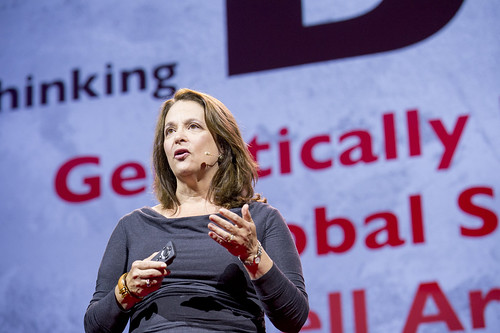“We have something that will radically save the pharmaceutical industry,” says Susan Solomon in an interview on the social floor of TEDGlobal 2012, in Edinburg, Scotland. Solomon is the founder and CEO of the New York Stem Cell Foundation. She spoke with the TED Blog about the NYSCF’s new array of automatically created stem-cell lines, which she talked about for the first time onstage at TEDGlobal.
On Wednesday, Solomon gave a talk on the promise of stem cells in research. In that talk, she discussed the process of drug development: it’s spectacularly expensive and time-consuming, taking 13 years and costing around $4 billion for a single drug, which will have a 99% failure rate. “That,” she says in the talk, “is a terrible business model, but also is a horrible social model.”
Part of the problem is, it’s impossible to test a new drug on a large and representative sample of the human population (which would be spectacularly unethical). But it means that a drug that tests well on some people will have side-effects, or be ineffective, on other people — a problem that’s sometimes not apparent until the drug is on the market and being prescribed to real patients. It’s not known exactly why this happens, and it could be due to differences in genes or other unknown factors.
To allow for much broader testing, Solomon and the team at NYSCF have created a machine that can roboticize the creation of stem-cell lines. This will produce a comprehensive array of stem-cells which can serve as a testbed for new drugs, allowing testing on a wide sample of human types. As she said in her talk:
By 2008, a scientist at the NYSCF was able to take skin cells, turn them into stem cells, then into motor neurons — the kinds that are damaged in ALS, or motor-neuron disease. Using that, he could watch the progress of the disease in a dish in living human cells. He found they were dying in very different ways than thought: They were being attacked by other cells. This was not possible to see before the model provided by the stem cells; it would have been like looking at a plane crash before the black box. Says Solomon, “Stem cells are the black box for diseases.”
The idea is that, if researchers had access to 25,000 different stem-cell lines, instead of just a few, they could test new drugs on a wide sample of human stem-cells before releasing it. That would not only avoid disasters like the deaths from adverse reactions to Vioxx, but also give people a sense ahead of time of what side-effects they might experience. “You want to know not just a list of side-effects,” said Solomon, but when looking at a specific side-effect, “Am I that person?”
The new array is built and is already producing stem-cell lines. It will be able to make 2,500 lines by the end of the year, a stunning increase over previous numbers. (In the past, all stem-cell lines were created by hand.) “We have the best stem cell scientists,” Solomon says of the NYSCF, “and we recapitulated their methods in software.” And they’ve designed the machine in a way that can adapt to new developments: “The only thing we know for sure is that techniques will improve.”
The next question: funding. Currently the NYSCF runs one shift on one machine, which produces the 2,500 lines a year. They could increase this by adding shifts or even a second machine — their eventual goal is to produce 25,000 stem-cell lines each year. They also plan to move the machine into a clean-room facility, to enable the lines to be used in research with more stringent requirements.
Solomon and her team are quite excited. “The goal is to change things so that we’re not waiting 13 years to find out a drug doesn’t work, or it harms you.”
Photo: James Duncan Davidson

Comments (4)
Pingback: 10 talks on the future of stem cell medicine | Technology is the CURE!
Pingback: 5 ideas for streamlining the way we test pharmaceuticals | Krantenkoppen Tech
Pingback: 10 talks on the future of stem cell medicine | Krantenkoppen Tech